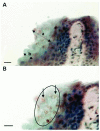Origin of the amphibian chytrid fungus
- PMID: 15663845
- PMCID: PMC3323396
- DOI: 10.3201/eid1012.030804
Origin of the amphibian chytrid fungus
Abstract
The sudden appearance of chytridiomycosis, the cause of amphibian deaths and population declines in several continents, suggests that its etiologic agent, the amphibian chytrid Batrachochytrium dendrobatidis, was introduced into the affected regions. However, the origin of this virulent pathogen is unknown. A survey was conducted of 697 archived specimens of 3 species of Xenopus collected from 1879 to 1999 in southern Africa in which the histologic features of the interdigital webbing were analyzed. The earliest case of chytridiomycosis found was in a Xenopus laevis frog in 1938, and overall prevalence was 2.7%. The prevalence showed no significant differences between species, regions, season, or time period. Chytridiomycosis was a stable endemic infection in southern Africa for 23 years before any positive specimen was found outside Africa. We propose that Africa is the origin of the amphibian chytrid and that the international trade in X. laevis that began in the mid-1930s was the means of dissemination.
Figures



Similar articles
-
Global emergence of Batrachochytrium dendrobatidis and amphibian chytridiomycosis in space, time, and host.Annu Rev Microbiol. 2009;63:291-310. doi: 10.1146/annurev.micro.091208.073435. Annu Rev Microbiol. 2009. PMID: 19575560 Review.
-
Batrachochytrium dendrobatidis infection of amphibians in the Doñana National Park, Spain.Dis Aquat Organ. 2012 Mar 20;98(2):113-9. doi: 10.3354/dao02419. Dis Aquat Organ. 2012. PMID: 22436459
-
Survey for the amphibian chytrid Batrachochytrium dendrobatidis in Hong Kong in native amphibians and in the international amphibian trade.Dis Aquat Organ. 2007 Dec 13;78(2):87-95. doi: 10.3354/dao01861. Dis Aquat Organ. 2007. PMID: 18286805
-
Widespread occurrence of the amphibian chytrid fungus Batrachochytrium dendrobatidis in the southeastern USA.Dis Aquat Organ. 2008 Oct 16;82(1):3-18. doi: 10.3354/dao01974. Dis Aquat Organ. 2008. PMID: 19062748
-
Antimicrobial peptide defenses against chytridiomycosis, an emerging infectious disease of amphibian populations.Dev Comp Immunol. 2005;29(7):589-98. doi: 10.1016/j.dci.2004.11.004. Epub 2005 Jan 13. Dev Comp Immunol. 2005. PMID: 15784290 Review.
Cited by
-
Germ tube mediated invasion of Batrachochytrium dendrobatidis in amphibian skin is host dependent.PLoS One. 2012;7(7):e41481. doi: 10.1371/journal.pone.0041481. Epub 2012 Jul 20. PLoS One. 2012. PMID: 22911798 Free PMC article.
-
Emerging infectious disease and the loss of biodiversity in a Neotropical amphibian community.Proc Natl Acad Sci U S A. 2006 Feb 28;103(9):3165-70. doi: 10.1073/pnas.0506889103. Epub 2006 Feb 15. Proc Natl Acad Sci U S A. 2006. PMID: 16481617 Free PMC article.
-
Evidence for acquisition of virulence effectors in pathogenic chytrids.BMC Evol Biol. 2011 Jul 8;11:195. doi: 10.1186/1471-2148-11-195. BMC Evol Biol. 2011. PMID: 21740557 Free PMC article.
-
Invasive American mink: linking pathogen risk between domestic and endangered carnivores.Ecohealth. 2014 Sep;11(3):409-19. doi: 10.1007/s10393-014-0917-z. Epub 2014 Mar 7. Ecohealth. 2014. PMID: 24604545
-
Distribution and Genetic Diversity of the Amphibian Chytrid in Japan.J Fungi (Basel). 2021 Jun 29;7(7):522. doi: 10.3390/jof7070522. J Fungi (Basel). 2021. PMID: 34210103 Free PMC article.
References
-
- Speare R; Core Working Group of Getting the Jump on Amphibian Disease. Nomination for listing of amphibian chytridiomycosis as a key threatening process under the Environment Protection and Biodiversity Conservation Act 1999. In: Speare R, Steering Committee of Getting the Jump on Amphibian Disease, editors. Developing management strategies to control amphibian diseases: decreasing the risks due to communicable diseases. Townsville, Australia: School of Public Health and Tropical Medicine, James Cook University; 2001. p. 163–84. Available from http://www.jcu.edu.au/school/phtm/PHTM/frogs/adms/attach7.pdf
-
- Lips KR. Mass mortality of the anuran fauna at an upland site in Panama. Conserv Biol. 1999;13:11725. 10.1046/j.1523-1739.1999.97185.x - DOI
-
- Bonaccorso E, Guayasamin JM, Méndez D, Speare R. Chytridiomycosis in a Venezuelan amphibian (Bufonidae: Atelopus cruciger). Herpetol Rev. 2003;34:331–4.
Publication types
MeSH terms
LinkOut - more resources
Full Text Sources
